The Pros and Cons of DTF Transfers
DTF transfers are becoming extremely popular in the printing industry for many excellent reasons! Today we'll be sharing the pros and cons of DTF transfers so that you can decide if they are the right method for you.
The Pros:
1.) DTF Transfers are Extremely Versatile.
Unlike direct to garment printing, DTF transfers can be applied to materials that are 100% cotton, 50/50 cotton and polyester blends, and even 100% polyester! DTF transfers can be applied to both light and dark fabrics without any special treatments or extra steps.
In addition, DTF transfers can be applied to different types of surfaces such as luggage, shoes, and wood. You can put a DTF transfer on basically any porous material.

2.) Using DTF Transfers reduces your production time.
Once you've received your transfer(s) from us, all you need to do is press it on your garment using a heat press for 5-10 seconds! There's no need for pre-treatment, no time spent waiting for inks to dry, and no need to make multiple screens.
In addition, the better your heat press, the more streamlined and faster your process. To help you find the perfect press, we have also compiled a list of the best heat presses based on the volume of work you do.
3.) DTF Transfers reduce your cost significantly.
Your cost to decorate your material is simply your heat press cost, plus your garment cost, and transfer cost (our prices are some of the best and lowest in the industry).
If you currently decorate your own shirts using tradition screen printing methods or DTG, you won't have to spend extra money on inks, pre-treatments, or special garments when you switch to buying DTF transfers. Plus, you'll likely see a reduction in your utility bill because you no longer need to run large machinery or use water to wash screens.
In addition, since DTF application is so fast, you minimize production and labor costs and can even see profit on smaller jobs that don't traditionally make a profit.
4.) DTF Transfers are easy to use in many different areas other methods of printing can't reach.
Since all you need to apply a transfer is heat and some pressure, DTF transfers can easily be applied to tricky areas. For example, a DTF transfer can easily be applied to the bottom of a curved skateboard. It would be impossible to do this using other printing methods.
5.) They are more durable.
Direct to garment prints have a soft feel because the ink is applied directly to the garment. While DTF prints don’t have the soft feel that DTG can boast, DTF transfer prints are much more durable.
Prints transferred directly to film wash well and are elastic, meaning they don’t crack or flake, making them ideal for heavy use items.

6.) Reduces inventory
If your shop deals with a lot with inventory, DTF transfers can significantly reduce your inventory volume and cost by allowing you to stock less for less money.
For example, let's say you wanted to stock 20 shirts with a 6 color, 10"x10" print. Traditional screen printing would cost around $13.44 per print (including setup charges).
DTF Transfers from DTF Advantage would cost $3.25 per print for the same job. You save over $200 by ordering from DTF Advantage!
In addition, since DTF transfers are easy to apply and are small to store, you can choose to stock them so that you can apply them to multiple different materials and colors of materials to allow for variations and choices for your customers.
7.) Designs with many details and colors aren't an issue.
Complicated designs or designs with several colors aren't difficult to apply with DTF transfers and don't cost more or take up more time. Unlike screen printing, you don't have to set a limit on the colors you would like to use or be cautious of cost.
If your file is saved correctly and you use an experienced DTF printer, DTF transfers have incredibly vibrant color and details. We show you how to properly save your file before submitting it on our DTF order page so that your colors are as vibrant as you want them to be.
The Cons:
1.) DTF transfers aren't very breathable.
DTF prints feel hard and stretchy. Their breathability is not good when compared to direct to garment printing. DTF prints will become softer after washing, but they still will not feel like DTG prints.
To minimize this problem, make sure to find an experienced DTF printer. Typically, experienced DTF printers produce DTF prints with better texture because experienced printers typically have better equipment and have perfected the printing and applying process.
In addition, DTF printing is constantly evolving and new technology is making it possible for DTF transfers to feel softer. DTF breathability may not be a con in the near future.
2.) Ironing your garment at high temperatures may cause discoloration.
Unfortunately ironing your DTF printed garment at high temperatures may result in discoloration after the DTF transfer has been applied and cooled. For example, the white ink may become yellowish in appearance.
3.) Colors may deviate from your original design.
As with any printing method, colors may not match your original design. The best way to prevent this from happening is using Photoshop to save your file as a PNG and setting the "color profile" setting to sRGB. We have created a video to show you how to properly save your printing file and you can view it on our order page.
Using experienced DTF printers will give you the best odds of your colors matching well.
To further ensure that your colors match, we offer a color chart.
4.) You need to find a skilled DTF printer.
There's a lot that can go wrong with DTF printing like slow production time, banding, bad texture, dramatic color differences, poor quality of ink or film used, etc. It's important to find a quality, experienced printer that uses the best materials and one that has industrial quality machinery and equipment.
Many companies may try to sell DTF transfers using desktop DTF printers, but desktop printers do not provide the same quality or volume of prints as industrial machines. Plus, DTF printing requires careful calibration to discover what produces the best prints. At DTF Advantage, we use the best materials and machinery and have perfected our printing process.
In Summary:
DTF transfers are extremely versatile in that they can be printed on any color of materials and a wide variety of material composition, they reduce production time and cost depending on job size, allow for vibrant colors and designs, and are more durable than other methods of printing.
DTF transfers may have a few downsides, like poor breathability and color deviation, but finding a skilled DTF printing company can help reduce the significance of the downsides.
At DTF Advantage, we use industry best film, inks, powder and machinery. We have an average production time of just 1-2 days with some of the best prices in the industry! Order your transfers here.









